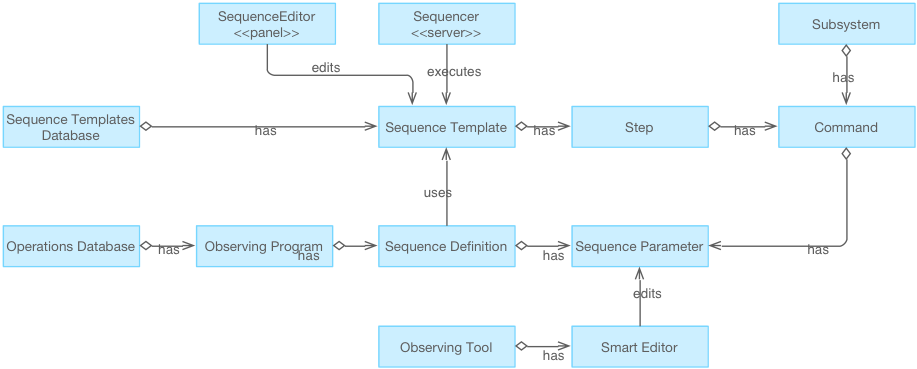4.7. Sequencer#
Activities scheduled for execution involve Sequences. Sequencing can greatly facilitate operational efficiency of highly complex systems whose subsystems must be orchestrated to operate in parallel or in series. The derived requirements for the Sequencing system are shown in Table 10-39. A sequence contains events that must be triggered in order to accomplish an activity (e.g., observation execution, instrument switch).
Title |
Statement |
|---|---|
Sequence Automation |
Provide the capability to arrange commands in a way that allows users to automate the execution of complex operations. |
Synchronous Instrument Operation |
Provide the capability to automate the observing activities that require multiple instruments operating synchronously or simultaneously. |
Automated Start-up/ Shut-down Procedures |
Provide the capability to execute start-up and shutdown processes that are initiated and monitored under operator control. |
Observing Mode Switching |
Provide the capability to switch from one observing mode to another. |
Acquisition Efficiencies for Observing Modes |
Provide the capability to complete target acquisition in Natural Seeing, LTAO, NGSAO, LGSAO, NGLAO, and reacquisition in all modes, within the time budgets specified in the GMT Efficiency Budget (GMT-SE-REF-00593). |
Telescope Optical Configuration Switching |
Provide the capability to switch from one telescope optical configuration to another in an automated way for any active instruments. |
Automated Instrument Switching |
Provide the capability to automate the switching of the active instrument set during the night initiated and monitored by the operator. |
Sequencers are often implemented via a hierarchical pattern: high-level sequencers control subordinated sequencers and so on. This makes complexity manageable, because there is only loose coupling between different subsystems/sequences. However, this approach makes it difficult to ensure that different threads, which might allow for parallel execution, can synchronize at different levels of the hierarchy. It also makes it difficult to visualize the execution status of every subsystem at any given moment in time.
For example, in a science observing sequence, a workflow is stored as a sequence template in the Observing Sequence Template Database. The workflow stages – target acquisition, target exposure, image calibration, etc. – are each refined into sequences of steps. During observing preparation or runtime, a user (an astronomer or an operator) defines parameters needed to execute the appropriate commands.
A Sequence template has Rules and Validations. Rules are conditions that have to be met during the execution of the sequence. They are different from observatory rules as they are only in place during the execution of the sequence. Validations ensure conformance between the parameters of the sequence and the sequence template.
During operations, it is often useful to monitor the status of certain operations. To aid in the comprehension of the system, a graphical tool allows editing, visualizing and executing a sequence in a two-dimensional arrangement. The graphical tool allows direct access to any parameter or command of the sequence. Any modification can be stored as a snapshot and recalled later. This feature is especially useful during commissioning. The tool also allows an operator to retrigger any command directly without the need to re-run or restart the sequence.
In this approach the sequence is not generated automatically from the Sequence Definition parameters, as this would require the generator to know about any arbitrary combination of instrument, AO mode, and telescope observing modes. Instead, a browser-based observation definition tool is generated specific to each sequence template, showing what is appropriate for that sequence. The tool allows the observatory staff to create and commission new sequence templates that address new or refined observing modes. Doing so does not involve overhead costs to rewrite a sequence generator or to edit a sequence, which is normally not operator friendly or human readable, or is error prone. The SWCS runtime allows access to the software component’s metadata; this enables one to obtain information about the definition of any command, property or parameter of the system when creating new sequences.
In order to facilitate the commissioning of observing sequences and to provide the operators with the flexibility to react to unexpected scenarios during the execution of an observation, the Sequencer provides the following capabilities:
Several sequences can be in execution simultaneously
Sequence parameters can be modified in the middle of sequence execution
Steps of the sequence can be re executed in an arbitrary order
Sequence snapshots allow a modified sequence to be stored as a new sequence template
The master sequence panel enables visualization of all the sequences being executed at the observatory in a given moment. Each sequence has a set of resources that are required. Concurrent sequences cannot share resources that are exclusive
Step by step execution mode
Command by command execution mode
Support for parallel execution of commands
Ability to pause a sequence and re-execute a previous command with a new input value
Partial re-execution
Rules that monitor the state of the system and trigger actions can be defined per sequence
Default parameters per sequence
Figure 4.15 provides a class diagram of the main components of the observatory operations architecture. The behavior of predefined operation sequences is captured using Sequence Templates. Examples of sequences include engineering, diagnostic, calibration or observation tasks, among others. Sequence templates are stored in a database and are organized according several categories like “target instrument” or “observing mode.”

Fig. 4.15 Observatory Operation Main Modeling Entities#
While sequence templates capture the behavior of the observation, observation instance parameters of the sequence are captured as Sequence Definitions composed of Sequence Parameters. Sequence parameters are created with the assistance of Observing Tools during Phase I and Phase II. Sequence definitions are paired with sequence templates and are stored in the Operations Database, which constitutes the observatory backlog.